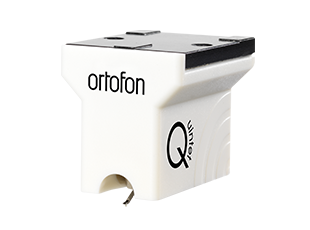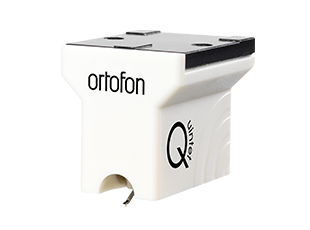Abbey Road Studios, 8th July 2014
I attended a listening session of the new The Beatles in Mono LPs, held in Studio 3. It was the first time these master-tape derived LPs have been played in the UK. The USA has already received the presentations, it is such an overwhelmingly important market in terms of sales, as well as enthusiasm, The arm carried an Ortofon Quintet Mono moving coil cartridge - HIFI World
Highly dynamic and low noise with mono LPs - Audio Magazine
The Quintet Mono is a new true Mono from Ortofon
True mono cartridge for playing mono microgroove vinyl records.
No-Brainer Solution for Hearing Your Mono Vinyl Sound Its Best: Ortofon Quintet Mono Pin Arrangement Eliminates Need for Mono-Specific Equipment
It features Nude Elliptical r/R 8/18µm stylus that is a good solution for playing mono microgroove vinyl records. The Quintet Mono will track perfectly through even worn and damaged records and ensure the surface noise control.
Quintet Mono uses a strapped output to deliver the same output signal from both sets of pole pins. This effectively eliminates the need for mono-specific equipment, making it possible to enjoy true mono reproduction on any stereo playback system.
Quintet Mono is the best cartridge in the Quintet series to play monophonic records.
No-Brainer Solution for Hearing Your Mono Vinyl Sound Its Best: Ortofon Quintet Mono Pin Arrangement Eliminates Need for Mono-Specific Equipment
|
Technical data
|
|
|
| Output voltage at 1 kHz 5 cm/sec |
0.3 mV |
| Frequency range at -3 dB |
20-25.000 Hz |
| Frequency response 20 Hz - 20 kHz |
+/-2.0 dB |
| Tracking ability at 315 Hz at recommended tracking force *) |
70 μm |
| Compliance, dynamic, lateral |
15 μm/mN |
| Stylus type |
Nude Elliptical |
| Stylus tip radius |
r/R 8/18 μm |
| Tracking force range |
2.1-2.5 g (21-25 mN) |
| Tracking force recommended |
2.3 g (23 mN) |
|
| Tracking angle |
20º |
| Internal impedance, DC resistance |
5 Ohm |
| Recommended load impedance |
>20 Ohm |
| Cartridge body material |
ABS/Aluminium |
| Coil wire material |
Pure 4-nines silver |
| Cartridge colour |
White |
| Cartridge weight |
9 g |
It features Nude Elliptical r/R 8/18μm stylus that is a good solution for playing mono microgroove vinyl records. The Quintet Mono will track perfectly through even worn and damaged records and ensure the surface noise control. Quintet Mono uses a strapped output to deliver the same output signal from both sets of pole pins. This effectively eliminates the need for mono-specific equipment, making it possible to enjoy true mono reproduction on any stereo playback system.
Quintet Mono is the best cartridge in the Quintet series to play monophonic records.
The MC Quintet Series is congruent with Ortofon’s unrelenting commitment to providing the most precise and accurate reproduction possible without colouration.
A special ABS (Acrylonitrile/Butadiene/Styrene) thermoplastic material is used for manufacturing of the body. This light-weight, impact resistant material is very suitable for injection-moulding and provides a very durable scratch resistant surface.
Neodymium magnets are implemented to achieve an optimal output.
Low internal impedance makes the cartridge less sensitive to load and therefore ensures compatibility with the widest range of preamps and transformers.
A special ABS (Acrylonitrile/Butadiene/Styrene) thermoplastic material is used for manufacturing of the body. This light-weight, impact resistant material is very suitable for injection-moulding and provides a very durable scratch resistant surface.
Neodymium magnets are implemented to achieve an optimal output.
Low internal impedance makes the cartridge less sensitive to load and therefore ensures compatibility with the widest range of preamps and transformers.
Ortofon is the world’s oldest and most experienced manufacturer of hi-fi pick-up cartridges. From humble beginnings in 1918, Ortofon is now a prolific winner of various international awards, and consistently well reviewed by the international press with every new product. Their core principles of responsibly sourced high-end materials, meticulous design and production processes, pristine working conditions and superlative attention to detail are evident in every single product they make.
From the introductory moving magnet OM and 2M models, through the Vivo, Rondo and Cadenza Moving Coil series, all the way up to the high-end MC Windfeld, Xpression and brand new MC Anna cartridges, Ortofon are devoted to offering true ‘accuracy in sound’. They also commit to supporting long-time customers by continuing to run replacement styli many years after an original cartridge has been discontinued, and for Moving Coil customers they also run an attractive Exchange Program .
Nothing demonstrates Ortofon's long-standing resilience more than its commitment to the refinement of analogue sound quality and its continued development of new cartridge models. Since 1948 Ortofon have introduced about 100 different moving coil models, with their latest being the Quintet Series.
Ortofon believe the cartridges in this new series are more than worthy successors to the long line of models that have made Ortofon the global leader in the manufacturing and supplying of phono cartridges.
The Mono Microgroove
The mono microgroove geometry is fairly easy to understand, as it only has to contain one signal. That signal is cut in the lateral dimension only, meaning that the V-shaped groove will have constant width and depth. The groove angle of the V-shape will vary a bit from record to record but will always be close to 90 degrees. The top width of the groove will, according to the different standards, have a minimum dimension in order to ensure that the replay stylus can sit comfortably inside the groove. Over the years, this minimum width has varied due to changing standards but has always been close to 50µm until the mid 1960s. The latest standards from the 1980s were revised for a minimum width down to around 30µm. This offered a unified standard, congruent to the minimum width of stereo records.
Regarding the bottom groove radius, old microgrooves from around 1950 could approach 15µm, or even larger if the record stamper was used for too long. Records like that need to be played only by a cartridge with a spherical 25µm stylus, otherwise there is a risk of the stylus bottoming out and causing poor fidelity. From around the mid 1950s, the bottom radius was reduced to around 8µm, which corresponds to the IEC98 standard from 1958 where 7.5µm is stated as maximum radius. Later on, up to the stereo age, this was further reduced down to 4µm. The bottom radius is one of the important factors determining which styli will replay the record satisfactorily .
Understanding the differences in groove types
Mono versus StereoA stereo record contains the left-right information on the two opposing groove-walls that are angled at +/-45 degrees, as is seen in the figure above. Cutting the groove this way leaves us with a complicated shape with both lateral and vertical information which a stereo cartridge is able to read.
A mono record contains only one signal corresponding to left+right which is cut in the lateral direction, so there is no vertical information.
If you play a mono record with a stereo cartridge you will not achieve the same signal in the two channels due to imperfections such as crosstalk, noise, phase errors, tracking error, antiskating and distortion. This difference between the channels will result in an unstable and partially fuzzy image. A mono switch, to some extent, can improve this.
Playing the same record with a mono cartridge will have none of the aforementioned problems, as this cartridge only produces one signal, which afterwards is directed to both channels in the system. This will provide a much more forceful and stable image with a fuller sound.
Another significant advantage of using a mono cartridge to play mono records is the absence of response to vertical movement. This means that a mono cartridge is essentially impervious to the pinching effect which comes into action when the stylus is pushed vertically upward in very narrow grooves. In addition, the response to dust, dirt and wear will be reduced substantially as the vertical component will not be heard. The final result will be a much more clean and noiseless reproduction of the mono record. These effects simply cannot be achieved merely by the use of a mono switch.
The Styli
Spherical styli were the most commonly used geometry up to the beginning of the 1960s. Consequently, most records from the first 15 years of microgroove records have been played with a spherical stylus. This will not, however, mean that mono has to be played with a spherical stylus. In fact, elliptical types as well as line contact types can be highly beneficial for mono records from the mid 1950s and upwards (see figures below). The line contact types, specifically, will ensure an improved high frequency response due to the slim shape. Also the distortion from the pinching effect, which occurs when the stylus is pushed upwards due narrow high frequency grooves, will be reduced substantially.
Replaying an old mono record, which probably has been played only with a 25µm spherical stylus can be replayed in a different unworn location of the groove by using an 18µm spherical stylus or, even better, an elliptical or line contact stylus. Choosing one of these diamond profiles will dramatically increase the stylus’ ability to reproduce the inscription with detail and accuracy.
Lastly, a mono record cut with a properly aligned stereo cutterhead will be no different to using a mono head, as long as the signal supplied is the exact same for both channels. The cutting stylus chosen should also ensure the production of sufficiently deep and wide grooves in order to accommodate those users wanting to replay mono with a traditional spherical 25µm stylus.
One mono cartridge to play all the old and new mono records in existence
Many music lovers still have a lot of mono records in their collections. Many mono records first issued in the 1950s and 60s have also been reissued during the last years, such as Bob Dylan, Miles Davis, and Jimi Hendrix to mention only a few.
One the most significant things happened on the mono frontier has been the release of the Beatles mono box in September 2014.
25µm spherical stylus used in SPU Mono and SPU CG25 Di MkII
18µm spherical stylus used in 2M Mono
Line contact stylus used in MC Quintet Mono, MC Cadenza Mono and 2M Mono SE
FREE £ 75 Cartridge Set Up & Stylus Care Package
1 x Dust Buster Polymer Gel Stylus Cleaner
1 x Ortofon Cartridge Alignment Gauge / Protractor
1 x Digital Electronic Stylus Force Guage
1 x Cardas 180g Test & Frequency Sweep & Burn-In Record
1 x Carbon Fibre Record Brush


